Lorsque nous avons commencé à utiliser Google AMP en 2016, cela semblait être l’avenir du web mobile. Mais au fil des ans, nous avons aidé des centaines de propriétaires de sites à s’éloigner d’AMP en raison de ses limites et de la modification de la position de Google sur l’indexation mobile-first.
Comme de nombreux utilisateurs/utilisatrices de WordPress, vous vous demandez peut-être s’il est temps de désactiver AMP sur votre site. Avec Google qui n’exige plus AMP pour les meilleures positions de recherche et la montée en puissance des vitrines web de base, nos lecteurs nous posent régulièrement des questions sur le retrait d’AMP.
Nous avons testé plusieurs méthodes pour désactiver correctement AMP à travers différentes configurations WordPress. Nous partagerons les approches les plus fiables qui ne nuiront pas à votre référencement ou à vos performances mobiles.
Que vous utilisiez l’extension AMP officielle ou un thème avec support AMP intégré, nous vous afficherons exactement comment effectuer cette transition en douceur.
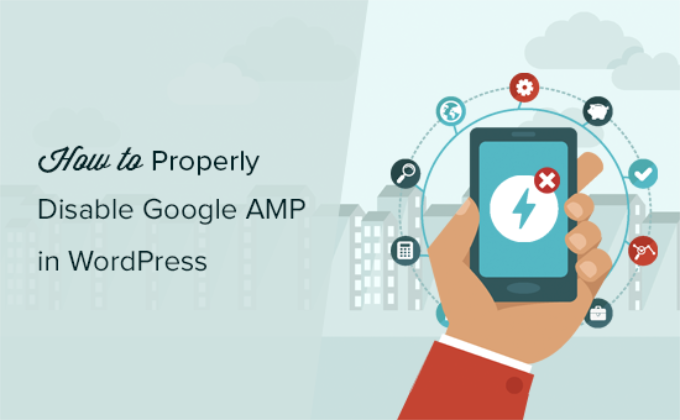
Pourquoi vous devriez désactiver Google AMP dans WordPress
Accelerated Mobile Pages (AMP) est une initiative open-source visant à rendre le web plus rapide pour les utilisateurs/utilisatrices mobiles et à améliorer l’expérience utilisateur.
Pour ce faire, il sert des pages avec un minimum de HTML et de JavaScript. Vous permettez ainsi au contenu d’être hébergé dans le cache AMP de Google. Google peut alors servir cette version cache aux utilisateurs/utilisatrices instantanément lorsqu’ils/elles cliquent sur votre lien dans les résultats de recherche.
Cependant, si vous avez choisi de configurer Google AMP dans WordPress, vous pourriez avoir l’impression d’avoir fait le mauvais choix.
Vous n’êtes pas le seul. De nombreux blogueurs, influenceurs et publications en ligne ont cessé d’utiliser AMP sur leurs sites WordPress.
Tout d’abord, nous allons voir pourquoi vous pouvez envisager de désactiver l’AMP sur votre site WordPress, puis nous vous guiderons à travers le processus.
Google Analytics 4 ne supporte pas AMP
Google Analytics 4 ou GA4 est la dernière version de Google Analytics qui assure le suivi de votre site et de vos applications mobiles dans le même compte. Elle apporte de nombreuses modifications, notamment de nouvelles méthodes de suivi, de nouvelles fonctionnalités de reporting, de nouvelles métriques et de nouveaux rapports.
Parmi ces modifications, il y a le fait que GA4 ne supporte pas officiellement AMP pour le moment, et il n’est pas confirmé si cela fonctionnera à l’avenir. L’une des raisons est qu’il suit les internautes de votre site et de votre app dans la même propriété.
Cependant, Google a déclaré que vous serez uniquement en mesure d’accéder aux anciennes données dans la propriété Universal Analytics jusqu’au 1er juillet 2024. Cela signifie que vous pouvez toujours accéder aux rapports Universal Analytics pour voir les données passées, mais que vous ne pourrez pas encore les suivre dans la dernière version.
Avancée spectaculaire des taux de conversion
Google AMP définit de nombreuses restrictions en matière d’HTML/JavaScript. Cela signifie que de nombreux éléments interactifs de votre site WordPress disparaissent avec AMP, comme les formulaires d’optin et les fenêtres surgissantes.
Les propriétaires de sites ne peuvent donc pas encourager les utilisateurs/utilisatrices à s’abonner, à remplir des formulaires de contact ou à acheter des produits.
Moins de pages vues par les utilisateurs/utilisatrices mobiles
AMP n’affiche pas les colonnes latérales de votre site ni les autres fonctionnalités de découverte de contenu. Cela entraîne une Avancée significative des pages vues par les utilisateurs/utilisatrices mobiles.
En fait, certains experts en expérience utilisateur suggèrent que le bouton de fermeture en haut de page encourage en réalité les utilisateurs/utilisatrices à revenir à la recherche Google après avoir lu votre article au lieu de naviguer sur votre site.

Diminution de l’engagement des utilisateurs/utilisatrices
De nombreux sites prospèrent grâce aux interactions avec les utilisateurs, comme les widgets click-to-tweet, les évaluations des utilisateurs, les commentaires, etc. Google AMP rend assez difficile pour les propriétaires de sites de garder les utilisateurs/utilisatrices engagés et d’interagir avec leur contenu.
Faut-il désactiver Google AMP ?
La réponse à cette question dépend en fait de votre site. Si les utilisateurs/utilisatrices mobiles constituent la majorité de votre public, alors vous pouvez toujours utiliser AMP.
En revanche, si vous avez essayé Google AMP et que cela a eu un impact négatif sur vos taux de conversion, alors vous devriez probablement désactiver Google AMP sur votre site.
Contrairement aux idées reçues, Google ne pénalise pas les sites qui n’utilisent pas AMP. Vous pouvez toujours améliorer la vitesse et les performances de votre site sur mobile afin d’être compétitif pour une audience de recherche mobile.
Avec tout cela à l’esprit, voyons comment vous pouvez désactiver AMP sur votre site WordPress.
Désactiver les extensions Google AMP dans WordPress
Tout le monde n’utilise pas les mêmes extensions WordPress pour ajouter le support AMP à leur site. Cependant, les réglages de base restent les mêmes quelle que soit l’extension utilisée.
La première chose à faire est de désactiver l’extension AMP que vous avez installée.
Il vous suffit de vous rendre sur la page ” Plugins ” Installed Plugins de votre tableau de bord WordPress et de cliquer sur ” Désactiver ” en dessous du nom du plugin AMP.
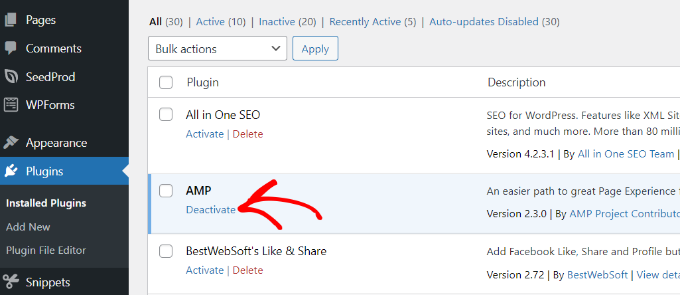
Il suffit de désactiver l’extension pour désactiver le support AMP sur votre site. Cependant, il y a quelques étapes supplémentaires à suivre pour s’assurer que votre site est exempt d’AMP.
Configurer les redirections pour les pages AMP
En désactivant l’extension AMP, vous retirez la version AMP de vos articles du site. Cependant, cela ne suffit pas, surtout si vous avez activé AMP depuis plus d’une semaine.
Il y a de fortes chances que Google ait déjà indexé ces pages et qu’il continue à les afficher dans les résultats de recherche. Si un compte clique sur l’une d’elles et que vous l’avez retirée de votre site, il trouvera une page 404 puisque ce contenu est désormais manquant.
Pour corriger ce problème, vous devez rediriger les utilisateurs/utilisatrices qui arrivent sur les pages AMP vers les pages ordinaires non AMP.
Nous allons vous afficher deux méthodes différentes pour configurer les redirections pour Google AMP, d’abord en utilisant une extension, puis en utilisant du code. Vous pouvez choisir celle qui vous convient le mieux.
Méthode 1 : Utilisation d’une extension de redirection
La façon la plus simple de configurer une redirection dans WordPress est d’utiliser l’extension All in One SEO (AIOSEO). C’est la meilleure extension SEO pour WordPress qui offre un gestionnaire de redirection puissant.
Note : vous aurez besoin de la licence AIOSEO Pro car elle inclut le gestionnaire de redirection.
Tout d’abord, vous devrez installer et activer l’extension All in One SEO (AIOSEO). Pour plus de détails, consultez notre guide étape par étape sur l’installation d’une extension WordPress.
Une fois l’activation effectuée, vous pouvez vous rendre dans All in One SEO ” Redirects à partir du Tableau de bord WordPress et cliquer sur le bouton ” Activer les redirections “.
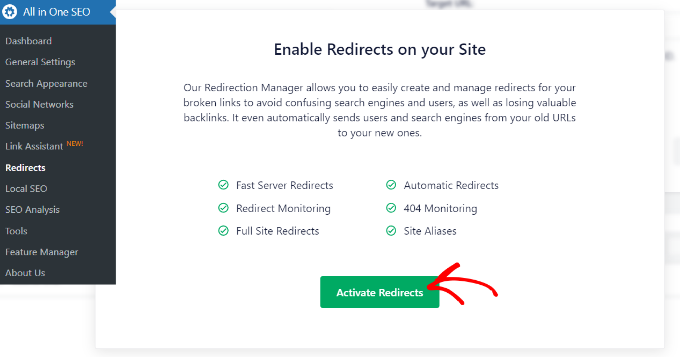
Cela vous aidera à installer le module AIOSEO Redirection Manager qui gère cette fonctionnalité. Une fois activé, vous serez dirigé vers l’onglet ” Redirections “. Ici, vous pouvez saisir les URLs source et cible pour configurer la redirection.
Tout d’abord, vous devez cliquer sur l’icône “Engrenage” dans le champ URL source, puis activer la case à cocher “REGEX”.
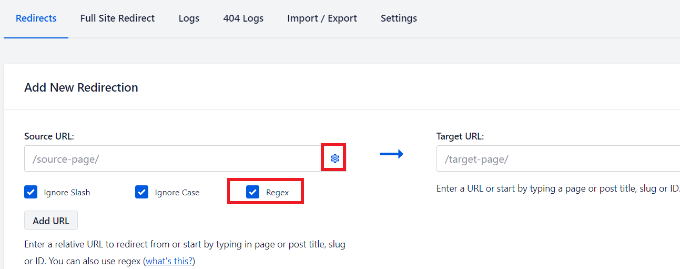
Ensuite, vous pouvez ajouter le code suivant dans le champ URL source :
1 | ^/(.*)\/amp |
Dans le champ URL cible, vous devez ajouter l’URL de votre site au format abonné :
1 | https://example.com/$1 |
N’oubliez pas de remplacer “exemple.com” par votre propre nom de domaine.
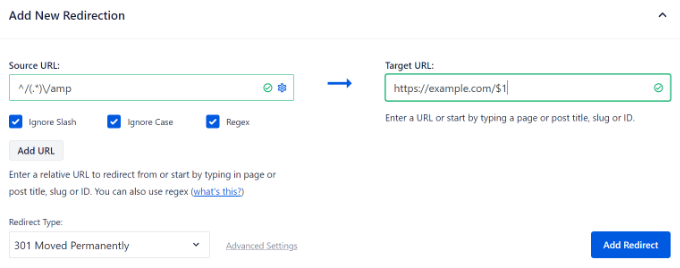
Ensuite, vous pouvez conserver le “Type de redirection” comme 301 Moved Permanently. De cette manière, vos utilisateurs/utilisatrices seront redirigés de manière permanente vers les pages non AMP.
Enfin, cliquez sur le bouton “Ajouter une redirection” pour enregistrer vos modifications.
Vous pouvez désormais visiter l’URL d’une ancienne page AMP sur votre site pour voir si la redirection fonctionne correctement.
AIOSEO vous aide également à suivre les liens brisés sur votre site. Vous pouvez rapidement identifier les pages AMP qui prospectent des erreurs 404 et les rediriger. Pour plus de détails, Veuillez consulter notre guide sur la façon de suivre les pages 404 et de les rediriger dans WordPress.
Méthode 2 : Définir manuellement les redirections dans le fichier .htaccess
Si vous ne souhaitez pas utiliser une extension pour définir les redirections, vous pouvez configurer la redirection à l’aide du fichier .htaccess de votre compte d’hébergement WordPress.
Tout d’abord, vous devrez vous connecter à votre site à l’aide d’un client FTP ou du gestionnaire de fichiers dans cPanel. Pour plus de détails, veuillez consulter notre guide sur l’utilisation du FTP pour téléverser des fichiers dans WordPress.
Une fois connecté, vous devez localiser le fichier .htaccess dans le dossier racine de votre site.

Ensuite, vous pouvez modifier le fichier dans votre dossier racine.
Il suffit ensuite d’ajouter le code suivant au bas de votre fichier .htaccess :
1 2 3 4 | // Redirect AMP to non-AMPRewriteEngine OnRewriteCond %{REQUEST_URI} (.+)/amp(.*)$RewriteRule ^ %1/ [R=301,L] |
N’oubliez pas d’enregistrer vos modifications et de téléverser le fichier sur votre serveur.
Vous pouvez désormais consulter l’URL de l’ancienne version AMP de n’importe quelle publication sur votre site pour vous assurer que la redirection fonctionne comme prévu.
Nous espérons que cet article vous a aidé à désactiver correctement Google AMP sur WordPress. Vous voudrez peut-être aussi consulter notre guide ultime de référencement WordPress étape par étape pour les débutants et les meilleures astuces pour accélérer WordPress.
Si vous avez aimé cet article, veuillez alors vous abonner à notre chaîne YouTube pour obtenir des tutoriels vidéo sur WordPress. Vous pouvez également nous trouver sur Twitter et Facebook.





Adeel Qadir
Thanks for such a nice article and your way of explaining was very simple. With this helpful article, I have easily redirected my website and remove AMP successfully.
Lots of thanks
WPBeginner Support
You’re welcome, glad our guide was helpful
Admin
Parkashjit Singh
Hi Sir, i following all the steps but, i saw all the amp link on google which are ranked now how i can removed that amp ranked links on google. As well when i search on google about my site then i saw amp logo after my site tittle even now I’m not using apm. Now how i removed that icon.
WPBeginner Support
You would need to have Google recrawl your site to start removing the content from Google’s search results.
Admin
Parkashjit Singh
How, is there any tutorial or bog. Please send me
WPBeginner Support
You can find our article on how to do this below:
https://www.wpbeginner.com/wp-tutorials/how-to-ask-google-to-recrawl-urls-of-your-wordpress-site/
Raj Deep
My site uses ssl and is on https. Should I use https or http in the redirection ?
WPBeginner Support
Use HTTPS
Admin
Robin
Hey I have page which have /?amp AMP format. So what change I have to do for proper redirection,
As the code given above /(.*)\/amp is only redirection pages with /amp.
Please tell me what change required for this ? thing.
WPBeginner Support
You could create an additional redirect where you add * before amp if you customized your amp URLs to show like that.
Admin
Bob Morris
Thanks. I found this article after one too many posts with 17 indecipherable AMP errors
WPBeginner Support
Glad our guide could be helpful
Admin
Farblos Kay
This is the best website to learn and fix anything WordPress. You guys are geniuses!
WPBeginner Support
Thank you, glad you find our content helpful
Admin
Subodh Gupta
I have disabled AMP on my site using the mentioned codes. But the post/page previews are showing in AMP mode. What to do? Using TagDiv NewsPaper theme.
WPBeginner Support
You would want to ensure you’ve cleared all of your caching for the most common reason for that.
Admin
Adnan
Yours AMP pages are in Google cache, so when Google Bot re-index and check no rel=”amphtml” tag they index non-AMP page.
Julia
Hi, this article sounds very useful, thanks for sharing!
Before I will deactivate/uninstall AMP plugin as well, I have to ask a question.
I have, by mistake, redirected few of amp links (with amp plugin already installed) to my normal url link:
example.com/amp to example.com
The reason why I did that redirect with redirection plugin, is that I had no knowledge of what amp is, and so I thought it’s an error, when I was migrating my site.
Now my question is, should I rather disable all my redirects with amp and then disable/uninstall the AMP plugin and then do the bulk redirect ?
Thank you for your help!
WPBeginner Support
To be safe you may want to create an export of your current redirects, remove them, then do the method in this article to prevent the possibility of multiple redirects
Admin
Pratik Bhatt
Hi,
Can you tell me, when we can remove the redirection plugin. Does google remove the amp pages automatically after some time?
WPBeginner Support
Once the amp pages are no longer being indexed you can remove the redirection. It takes time and Google recrawling your site for the links to be removed.
Admin
Pratik Bhatt
Thanks for the quicky reply.
One more question, I’ve to ask, If I don’t do the redirection, then still google remove the amp pages after some time?
Thanks.
WPBeginner Support
Eventually yes
sam
Hi
I followed the steps above. However, when searching on my mobile device the amp pages are still popping up (It’s only been a few hours so this may be why). When I search on desktop device and type in domain.com/amp the redirect works perfectly. Do you know why this is happening?
WPBeginner Support
You would need to clear any caching as the most common reason it would still be showing up.
Admin
Kuldeep Singh
Worked like a charm.
Thanks!
WPBeginner Support
Glad our guide was helpful
Admin
Jason
Great Guide! Worked like a charm.
WPBeginner Support
Thank you, glad our guide was helpful
Admin
ahs shaikh
thank you very much for this blog post…
WPBeginner Support
You’re welcome
Admin
Rahul sarawagi
Hey,
I tried this way and now my website is not loading, it is giving an error message that
” redirected you too many times ”
Please help me out in getting it back.
WPBeginner Support
For the too many redirects error, you would want to take a look at our guide here: https://www.wpbeginner.com/wp-tutorials/how-to-fix-error-too-many-redirects-issue-in-wordpress/
Admin
Dietrich
I have done method 1 and cleared/deleted cache and it still shows the AMP version? Any tips how to fix?
WPBeginner Support
You would want to check that your host does not have caching enabled and your redirects do no have any typos
Admin
Rohit verma
i have done the first method but it still shows amp version what to do?
WPBeginner Support
You would want to clear any caching as the most likely cause
Admin
Subham
Hi,
You guys are doing great.
After creating AMP i have seen down in my traffic.
So i decided to remove that and i did.
I got many errors. So, i had to install amp again.
Now finally this article helped me a lot to completely remove amp.
Thank you very much WPbeginner.
You are a lifesaver!
WPBeginner Support
Glad our guide could be helpful
Admin
Catherine Thomas
THANK YOU!!!! Method #1 worked perfectly!!!
WPBeginner Support
Glad our recommendations could help
Admin
Akash Gogoi
Can I disable redirection plugin after AMP completely gone from Google search result? Please help.
WPBeginner Support
If you would like you can. Be warned that would remove the redirects so if the links start appearing as broken links in your search console you may need to readd the redirects.
Admin
Enes
Hey. Thank you very much for the info but i had a question. It does not work with me method 1. it suppose to be non amp as soon as i do redirect right ?
my website is https so i made it as https that what it should be ? Thanks in advance
WPBeginner Support
If you are using https then you would want the second field as https, as long as you don’t have caching then it should automatically update. If not, you would want to reach out to the plugin’s support for them to take a look.
Admin
Suanlian Tangpua
When should I remove the redirection?
WPBeginner Support
As it would depend on if Google still links to your AMP pages, we don’t have a set time to remove it we would recommend at the moment.
Admin
Hiral
Hi, thanks for helping. I used method 1. All the blog posts are being displayed in proper format but home page, about, contact such pages are still being displayed in AMP. How to fix it?
WPBeginner Support
You may want to check with the author of the redirection plugin to ensure there isn’t a hiccup with the created redirect.
Admin
Elsaid
Thanks a lot
Now I disable and delete AMP Plugin. and redirect lINKS by first method.
but I have a question , If I want reinstall AMP plugin again
what I should do about redirections????
WPBeginner Support
You would need to remove the redirections.
Admin
Kumarpal Shah
I’ve used Method 1 – Using Redirection Plugin. Now, my question is after adding the redirection is it necessary to keep plugin installed & activated?
OR I can remove the plugin after adding the redirection?
WPBeginner Support
Using the plugin, you would need to keep the plugin active for the redirects to continue.
Admin
Mario
It worked for me wpbeginner thanks a lot
Amp is not advisable use
WPBeginner Support
Glad our article could help
Admin
foodstyling
Hi,
I used the redirection method and the AMP pages are redirected to fine, but the address remain as /?amp.
Should I worry?
WPBeginner Support
If the redirection is working correctly, then you do not need to worry about the urls.
Admin
Mark Llego
I would like to know how can I 301 redirect if my amp url is structured like this
site.com/amp/your-article/
I am using better amp.
Thank you.
WPBeginner Support
Hi Mark,
The htaccess method in this post should handle that redirect for you
Admin
Joanna
Thank you so much! I was struggling with accidentally adding AMP pages and then removing them to losing a lot of traffic. Then, I felt defeated, so I reinstalled AMP. Method 1 with the Redirection plug-in was so easy I wish I had seen this sooner. THANKS!!
WPBeginner Support
Glad our article could help
Admin
Rajesh Ranjan
hii, i followed each and every step but its not working on my WordPress website.
WPBeginner Support
If you removed AMP completely and clearing your cache did not remove the AMP versions you may want to check with your hosting provider to ensure they don’t have caching or similar that would be affecting the AMP pages.
Admin
Margaret
I’m using the Yoast plugin for redirects – what do I input and where to redirect my amp urls to my non-amp ones?
Manh Nguyen
I do as instructed, how long does my site return to normal ?
Thanks!
katie larking
Hi I disabled the AMP plugin and set up a redirect as per the article. The redirect works, but the AMP pages are still in google index and working. How long until google replaces them with my non amp pages. Please let me know how long it takes organically vs anything I can do to speed this up that is proven to work. Thankyou!
Aaron Hunter
This helped so much thank you! I’ve asked WP support, and they had nothing to offer me for a solution. The new version of WordPress.com doesn’t let you deactivate AMP so I used the Redirection plugin. Thank you again!!!
Keith Whitworth
You are an absolute lifesaver! After implementing AMP, my user engagement dropped significantly, my site links in Google totally disappeared, my ranking (for my niche) was at the bottom of the barrel.
AMP is not really designed for podcasts AT ALL.
Once I decided it wasn’t going to work out, I deleted the plugin only to generate thousands of 404 errors related to AMP. I found myself creating unnecessary laborious work creating redirects every day as they popped up.
Finally, I got frustrated and performed a search and replace in my database to remove amp/ which was a massive mistake. Suddenly my site was no longer available. I deleted the plugin and everything was restored but what to do about all the 404 errors related to AMP?
I ran across your website through a Google search and presto. In one fell swoop, all my headaches disappeared. My sitelinks have been restored and yesterday I received an email from Google stating that mobile-first indexing was enabled on my site.
I cannot thank you enough!
WPBeginner Support
Hi Keith,
We are glad you found the article helpful You may want to join us on Twitter for more WordPress tips and tutorials. Next time you come across an issue, don’t forget to search WPBeginner first for a solution
You may want to join us on Twitter for more WordPress tips and tutorials. Next time you come across an issue, don’t forget to search WPBeginner first for a solution 
Admin
virginia
and a little question, after deactivating AMP, can I delete it? is it safe to do so?
WPBeginner Support
Hi Virginia,
Yes, it is safe to delete the AMP plugin.
Admin
virginia
hi, I`ve been using AMP but it generated a lot of errors in Google Search console. I´m an amateur blogger so I can´t identify properly the reasons when something isn´t working.
A thing I´ve noticed with AMP is that they cherrypick which image they show as your featured image in a blogpost, and it´s NEVER your actual featured image!! they choose to show an image uploaded inside the body of the post. And I run a travel blog, so I have a lot of unattractive -but useful- images like “this is the almost-hidden-kiosk where you can buy tickets to Eiffel Tower for less”. Well..they decided to show THOSE images instead of my well-curated eye-catching images featuring each post… It´s a NO- NO !!
By the way I was affected by the Yoast SEO bug early this year (which erased the no-index labels in media files, so if someone googled my blog, random images -like pie charts- showed in the results AS PAGES and posts in my blog without a single word explaining anything… a nightmare). I´ve installed a plugin called “404 redirect” to get rid of that mess, redirecting images to actual posts. It´s working fine as much as I know!
I´m trying to redirect all my /amp pages to the original URL, but a few days ago they changed the way the /amp pages show in browsers… is isn´t anymore /blogname.com/posttitle/amp Where can I find my amp pages to copypaste them and redirect all of them to my proper URLs?
Great article! Thank you for giving me more valid reasons to unistall AMP.
Tom Darche
I used another regex based on this one:
/(.*)\/amp?\/
My regex match the same but also match “something-before/amp/ instead of only “something-before/amp”
Natalie
Hi, thanks for this. I have been following an alternative method which tries to remove all AMP URLS by labelling them as no index. This uses the real-time find and replace plugin… where you add this code to the find section of the plugin:
You then go to the AMP plugin, go to the SEO section and add the following code to the head section: The idea is, that this will then signal google to take your amp pages out of the search. It’s only been a couple of days, but google has only indexed more AMP pages so far, so I’m not sure if it’s going to work. You can then create a 404 redirect if you wish from AMP pages to non-amp urls. Only at this point do you disable the AMP plugin. Do you think this will work? I’m trying my best to do this without damaging my rankings. Also…. one more thing! Since installing AMP my traffic has dropped by around a third according to analytics. Is this just because google analytics is not registering visits to AMP pages? I did put my google analytics code in when I set up Google AMP, but that’s all I did, I didn’t add anything to analytics otherwise. Thank you!!
Sarah Carter
Thanks, very easy to follow. I’m adding in another reason to disable amp (I’ve been on the fence for a while), is that the Amazon affiliate link builder program does NOT support AMP, neither domany of the cookie plugins that folks have been using for GDPR compliance purposes.
Ross Graham
Exactly the same reason I dropped AMP. even when promoting my site and sharing direct page links many of my users still ended up on none AMP pages. I lost revenue and now My site is back to costing me money instead of earning me money. I could still see people are converting and clicking my links but yesterday when i had a huge boost in traffic, out of 500 link clicks, only 33 were captured by my affiliate programme.
Mirre
Thanks that was so easy!!
Simson
An hour ago I was on the page, how to install AMP. After setting up and going through some of the folks’ articles, I’m here.
Dan
I tried both methods and they don’t work
The .htaccess method causes a server error.
While the redirect method doesn’t work.
I use the plugin Yoast SEO, and they have Regex redirects but it won’t work for me.
Please help!
Aniket Bangar
Hi Dan,
Try
# Redirect AMP to non-AMP
RewriteEngine On
RewriteCond %{REQUEST_URI} (.+)/amp(.*)$
RewriteRule ^ %1/ [R=301,L]
I am sure you also copied the comment “/Redirect AMP to non-AMP ” which caused500 error
James Michael Sama
Hey there – I’m getting about 100k uniques per month from search traffic and turning off AMP because people aren’t subscribing – so thank you for this.
Quick question: Do I need to redirect every specific page URL from the AMP ones? There are about 800 articles on my site, and that would take forever.
I appreciate it!
– James
WPBeginner Support
Hi James,
Using the redirection plugin will automatically redirect all AMP URLs to regular ones.
Admin
Ashraf Jan
Thank you So Much dear…..!!! Will it affect Search traffic and AdSense?
Kane
Thanks a lot for this tutorial. another reason why it makes sense to disable google amp on your wordpress is the use of adsense. dynamic adsense ads will not roll out on amp pages.
Have you had any experiences on this?
Totally weird, as this is the way how google acutally earns money…
Manoj
Thanks for your detailed guidance. It’s really helpful. In the same way, how can I redirect users from my old permalink structure to the new structure? I was using http://www.example.com/month/sample-post permalink on the blog, later I changed it to http://www.example.com/post-name.
G. P. Gautam
Hi,
I have activated AMP for my website. And its been long time to set it up. Now I want to Disable AMP for my site. That is why I am following this guide. I do the same as you mention in method 2. When I save my .htaaccess file it shows me this message, “501 internal server error.”
What is this and how to solve this problem.
Please guite.
WPBeginner Support
Hi,
Please see our guide on how to fix internal server error in WordPress.
Admin
Emily Brown
Thanks for the great post. It is very helpful.
Kevin
I have done as you said above and added in the plugin, I have deactived the amp plugin but the redirect didn’t work. Google still sends me to the amp page.
My website is and I added /$1 after as above.
I put https instead of http as above. Have tried both ways.
Does it take time for google to get the redirects?
Any help would be great. My bouce rate is now at 70% and I think it is because of the Amp, it was about 20%
Thanks
WPBeginner Support
Hi Kevin,
Yes. Your site’s AMP pages are hosted and served from Google’s own cache. They will continue to appear in search results until Google crawl backs your site. This may take a few days, you can also initiate a crawl using Google Search Console (webmaster tools).
Admin
Ben
The best reason, your content should be your content you should not give Google the power to shut you off